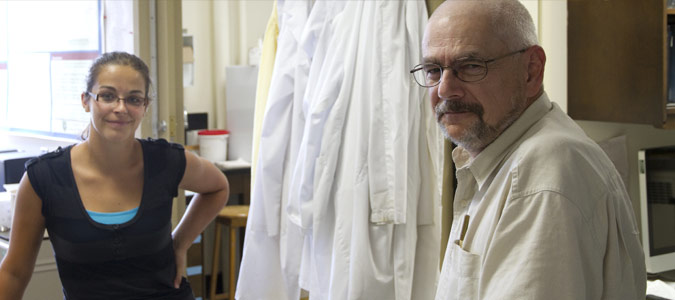Bacteria in a bottle
Beer can get sick, becoming ridden with bacteria, just like us humans. It is a topic that has been on Barry Ziola’s mind since the mid ‘80s.
By Colleen MacPherson In a conversation with Mike Ingledew, a famed U of S researcher on subjects like fermentation, brewing and fuel alcohol production, Ziola, with a background in microbiology and immunology, remarked that "detecting sickness in beer could be the same as with humans."
In a conversation with Mike Ingledew, a famed U of S researcher on subjects like fermentation, brewing and fuel alcohol production, Ziola, with a background in microbiology and immunology, remarked that "detecting sickness in beer could be the same as with humans."
Combining his curiosity about "sick beer" with an interest in applying knowledge in the real world, Ziola set out to discover what spoils the golden liquid. "Microbial quality control in breweries was really lacking back then. It could take weeks to months to detect bacteria," explained the pathology professor in the College of Medicine. "What we wanted to do was find a better and more rapid method of detection and identification of the bacteria that spoils beer."
Ziola estimates the financial losses due to spoilage that brewers experience are between $50-200 million globally each year. Because of this economic impact, his research has garnered industry support, most notably from Coors Brewing Company. More recently, industry support has been replaced with funding from NSERC in the form of a Discovery Grant to the tune of about $150,000 over five years.
The grant will enable Ziola and Vanessa Pittet, a health sciences PhD student in the College of Medicine, to identify and sequence the genomes of five strains of bacteria that wreak havoc on beer.
"There are tons of bacteria in breweries, but which bacteria spoil product and how they spoil it is what we need to understand," said Pittet. "Beer is a harsh environment for bacteria to survive in, but certain strains not only survive, but thrive in an environment with high alcohol, low nutrients and low oxygen—not to mention the antibiotic properties of hops. What they do in order to survive is very important."
They have already identified and sequenced one of the most common bacteria that plagues beer, and will do the same for four more strains of bacterium before the end of the grant. "We will be able to use this knowledge in a detection system. This system will detect the presence of bacteria in as little as six hours rather than 28 days," said Ziola.
The system, said Pittet, will predict and protect quality control for breweries. "If it is detected they can assess whether the concentration level will cause problems before the consumer drinks it," she explained.
Ziola is quick to point out that while these bacteria may offend the consumers' sense of smell and taste, they pose no real threat to health. "Spoiled beer can have a butterscotch flavor, a turbid appearance, produce slime or even smell like a
pig's barn, but won't cause
health problems."
The significance, Ziola explained, is the reaction a consumer has to a pig-barn-smelling lager. "That will cost you a customer for life," he said with a laugh. "Most breweries have a problem with bacteria, it is virtually impossible to eradicate. But if we can help with rapid detection, the brewery can be shut down and cleaned before it ships to consumers. They really need to be forever vigilant."

